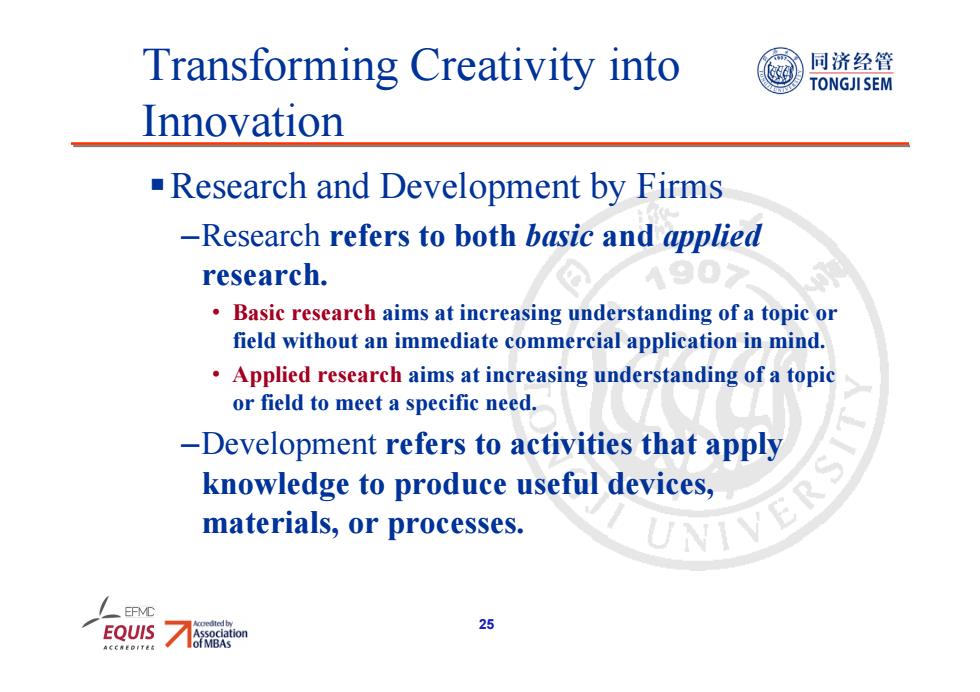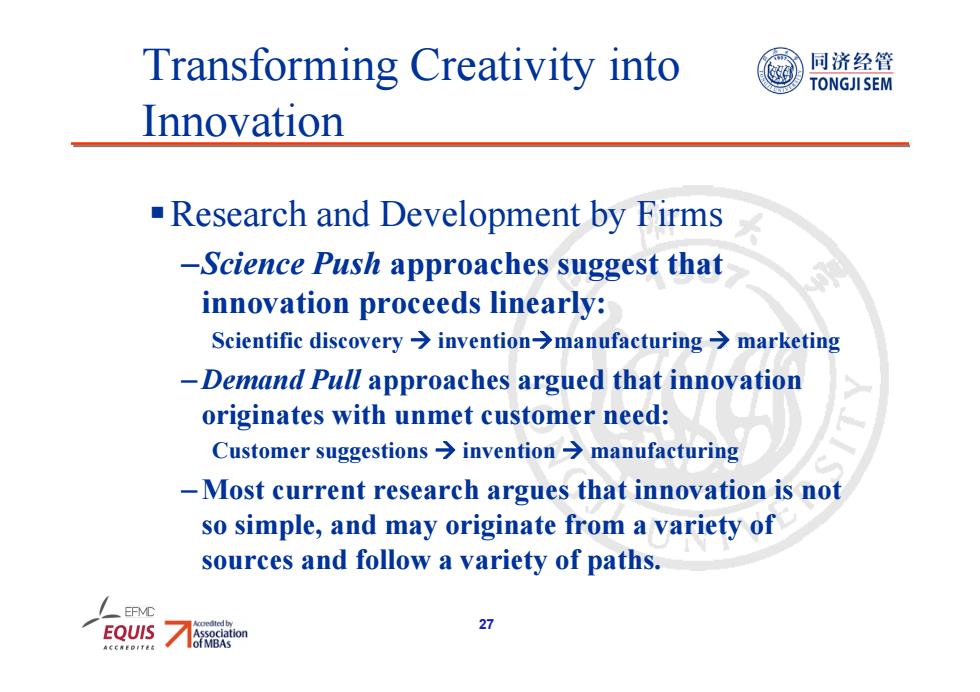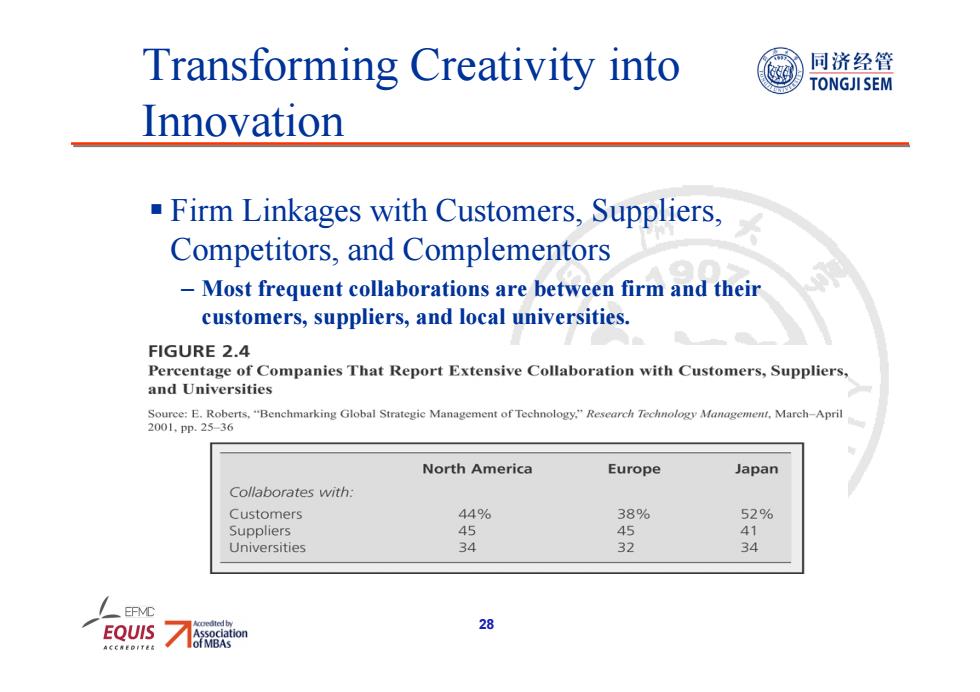
同济经管 Theory In Action TONGJI SEM The Birth of the Snowboarding Industry -First snowboards not developed by sports equipment manufacturers;rather they were developed by individuals seeking new ways of gliding over snow Tom Sims made his first"ski board"in wood shop class. ·Sherman Poppen made a“snurfer'”as a toy for his daughter later held "snurfing"contests Jake Burton added rubber straps to snurfer to act as bindings -By 2001 there were approximately 5.3 million snowboarders in the United States EQUIS 24
24 The Birth of the Snowboarding Industry – First snowboards not developed by sports equipment manufacturers; rather they were developed by individuals seeking new ways of gliding over snow • Tom Sims made his first “ski board” in wood shop class. • Sherman Poppen made a “snurfer” as a toy for his daughter – later held “snurfing” contests • Jake Burton added rubber straps to snurfer to act as bindings – By 2001 there were approximately 5.3 million snowboarders in the United States Theory In Action

Transforming Creativity into 同济经管 TONGJI SEM Innovation Research and Development by Firms -Research refers to both basic and applied research. Basic research aims at increasing understanding of a topic or field without an immediate commercial application in mind. Applied research aims at increasing understanding of a topic or field to meet a specific need. -Development refers to activities that apply knowledge to produce useful devices, materials,or processes. EQUIS 25
25 Transforming Creativity into Innovation Research and Development by Firms –Research refers to both basic and applied research. • Basic research aims at increasing understanding of a topic or field without an immediate commercial application in mind. • Applied research aims at increasing understanding of a topic or field to meet a specific need. –Development refers to activities that apply knowledge to produce useful devices, materials, or processes

Transforming Creativity into 同济经管 TONGJI SEM Innovation Research and Development by Firms -Most firms consider in-house R&D to be their most important source of innovation. FIGURE 2.3 Firms'Rank Ordering of the Importance of Sources for Research and Development Work, 1999 Source:E.Roberts."Benchmarking Global Strategic Management of Technology,"Research Technology Management.March-April 2001.pp.25-36 Rank Order of Sources of Rank Order of Sources of Research Work Development Work Central corporate research Internal R&D within divisions 2 Internal R&D within divisions Central corporate research Sponsored university research Suppliers'technology 4 Recruited students Joint ventures/alliances 56 Continuing education Licensing University liaison programs Customers'technology Consultants/contract R&D Continuing education Joint ventures/alliances Acquisition of products EQUIS 26
26 Transforming Creativity into Innovation Research and Development by Firms – Most firms consider in-house R&D to be their most important source of innovation

Transforming Creativity into 同济经管 TONGJI SEM Innovation -Research and Development by Firms -Science Push approaches suggest that innovation proceeds linearly: Scientific discovery→invention-→manufacturing→marketing -Demand Pull approaches argued that innovation originates with unmet customer need: Customer suggestions>invention>manufacturing -Most current research argues that innovation is not so simple,and may originate from a variety of sources and follow a variety of paths. EQUIS 27
27 Transforming Creativity into Innovation Research and Development by Firms –Science Push approaches suggest that innovation proceeds linearly: Scientific discovery Æ inventionÆmanufacturing Æ marketing –Demand Pull approaches argued that innovation originates with unmet customer need: Customer suggestions Æ invention Æ manufacturing –Most current research argues that innovation is not so simple, and may originate from a variety of sources and follow a variety of paths

Transforming Creativity into 同济经管 TONGJI SEM Innovation Firm Linkages with Customers,Suppliers, Competitors,and Complementors - Most frequent collaborations are between firm and their customers,suppliers,and local universities FIGURE 2.4 Percentage of Companies That Report Extensive Collaboration with Customers,Suppliers. and Universities SoerBenchmarking Global Strategie Management of Technology.Research Techmoloy Management.Marh-April North America Europe Japan Collaborates with. Customers 44% 38% 52% Suppliers 45 45 47 Universities 34 32 34 EQUIS 28
28 Transforming Creativity into Innovation Firm Linkages with Customers, Suppliers, Competitors, and Complementors – Most frequent collaborations are between firm and their customers, suppliers, and local universities